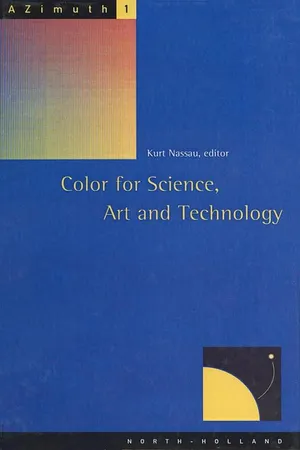
- 490 pages
- English
- ePUB (mobile friendly)
- Available on iOS & Android
Color for Science, Art and Technology
About this book
The aim of this book is to assemble a series of chapters, written by experts in their fields, covering the basics of color - and then some more. In this way, readers are supplied with almost anything they want to know about color outside their own area of expertise. Thus, the color measurement expert, as well as the general reader, can find here information on the perception, causes, and uses of color. For the artist there are details on the causes, measurement, perception, and reproduction of color. Within each chapter, authors were requested to indicate directions of future efforts, where applicable. One might reasonably expect that all would have been learned about color in the more than three hundred years since Newton established the fundamentals of color science. This is not true because: • the measurement of color still has unresolved complexities (Chapter 2)• many of the fine details of color vision remain unknown (Chapter 3)• every few decades a new movement in art discovers original ways to use new pigments, and dyes continue to be discovered (Chapter 5)• the philosophical approach to color has not yet crystallized (Chapter 7)• new pigments and dyes continue to be discovered (Chapters 10 and 11)• the study of the biological and therapeutic effects of color is still in its infancy (Chapter 2).Color continues to develop towards maturity and the editor believes that there is much common ground between the sciences and the arts and that color is a major connecting bridge.
Frequently asked questions
- Essential is ideal for learners and professionals who enjoy exploring a wide range of subjects. Access the Essential Library with 800,000+ trusted titles and best-sellers across business, personal growth, and the humanities. Includes unlimited reading time and Standard Read Aloud voice.
- Complete: Perfect for advanced learners and researchers needing full, unrestricted access. Unlock 1.4M+ books across hundreds of subjects, including academic and specialized titles. The Complete Plan also includes advanced features like Premium Read Aloud and Research Assistant.
Please note we cannot support devices running on iOS 13 and Android 7 or earlier. Learn more about using the app.
Information
Fundamentals of Color Science
1.1 Introduction
1.2 Defining color
1.3 Early views on color
1.4 Newton, the spectrum, and “colored” light
Table of contents
- Cover image
- Title page
- Table of Contents
- Copyright page
- Dedication
- Preface
- List of Contributors
- Biographical Notes
- Section I: The Science of Color
- Section II: Color in Art, Culture and Life
- Section III: Colorant, the Preservation and the Reproduction of Color
- Index